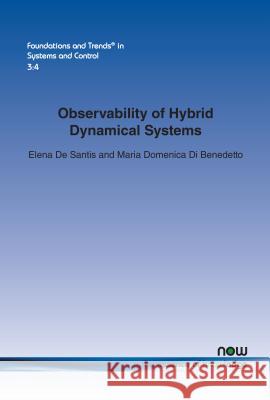Observability of Hybrid Dynamical Systems » książka
Observability of Hybrid Dynamical Systems
ISBN-13: 9781680832204 / Angielski / Miękka / 2016 / 196 str.
Hybrid systems have many applications in automotive, such as engine, brake and stability control, air traffic control and manufacturing plant control. The most effective hybrid control algorithms are based on full state feedback. However, in most cases, only partial information about the internal state of the hybrid plant can be measured. Observability is of fundamental importance to establish the conditions for reconstruction of the state of a system and has been thoroughly investigated in the continuous and discrete domain but not for hybrid systems. Written in a tutorial style, this monograph reviews and places in context how the continuous and the discrete dynamics, as well as their interactions, intervene in the observability property of a quite general class of hybrid systems: linear hybrid systems called H-systems. It provides a tutorial on hybrid systems observability in its various forms to students in control and its application as well as to practitioners in the field.
Hybrid systems have many applications in automotive, such as engine, brake and stability control, air traffic control and manufacturing plant control. The most effective hybrid control algorithms are based on full state feedback. However, in most cases, only partial information about the internal state of the hybrid plant can be measured. Observability is of fundamental importance to establish the conditions for reconstruction of the state of a system and has been thoroughly investigated in the continuous and discrete domain but not for hybrid systems. Written in a tutorial style, this monograph reviews and places in context how the continuous and the discrete dynamics, as well as their interactions, intervene in the observability property of a quite general class of hybrid systems: linear hybrid systems called H−systems. It provides a tutorial on hybrid systems observability in its various forms to students in control and its application as well as to practitioners in the field.











